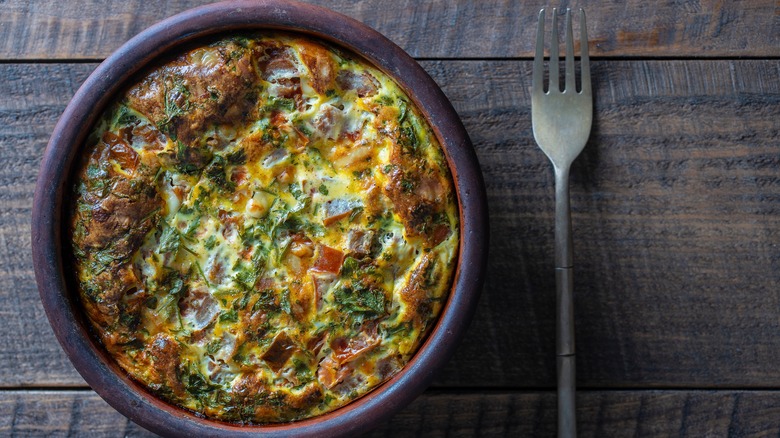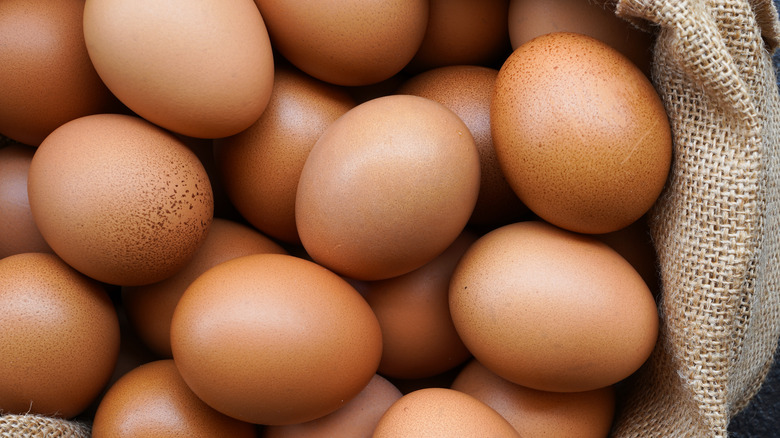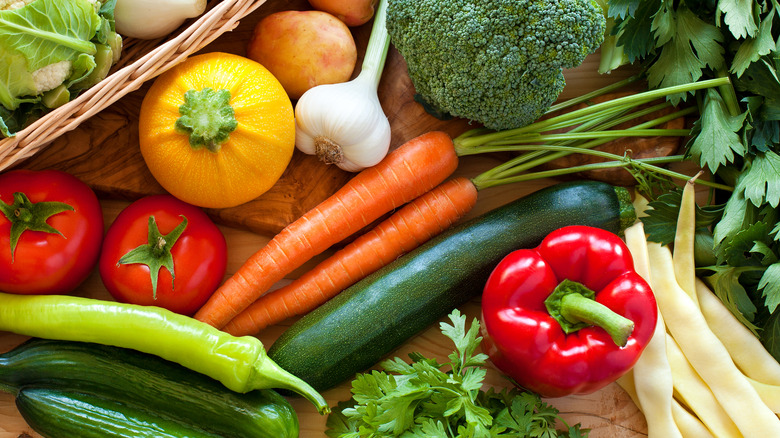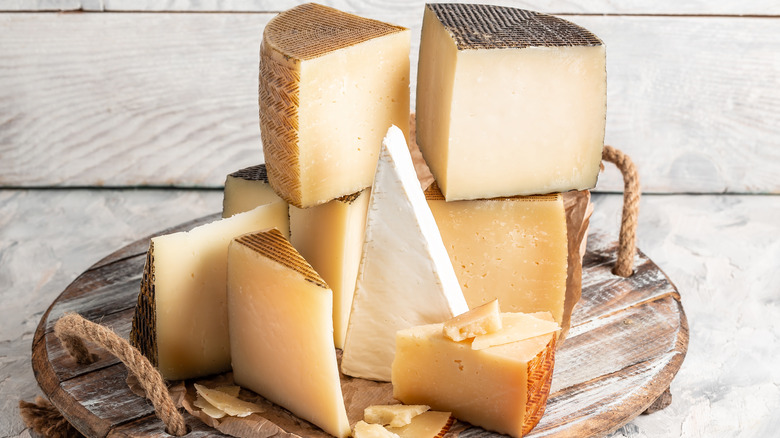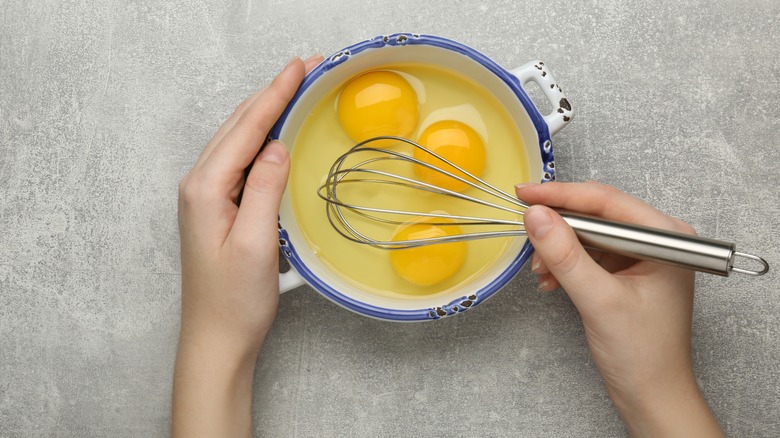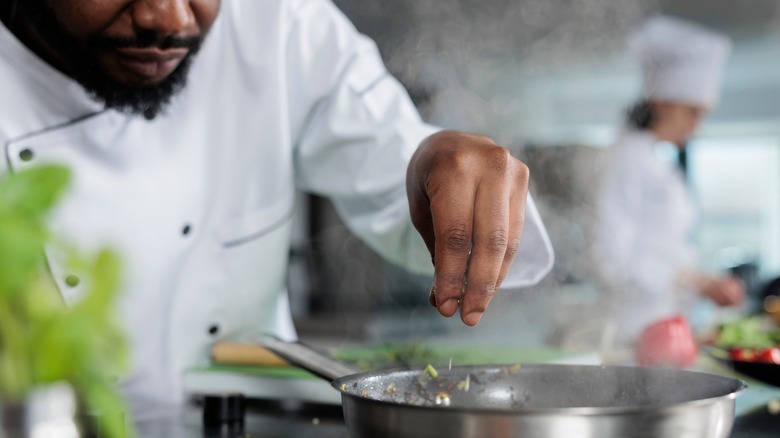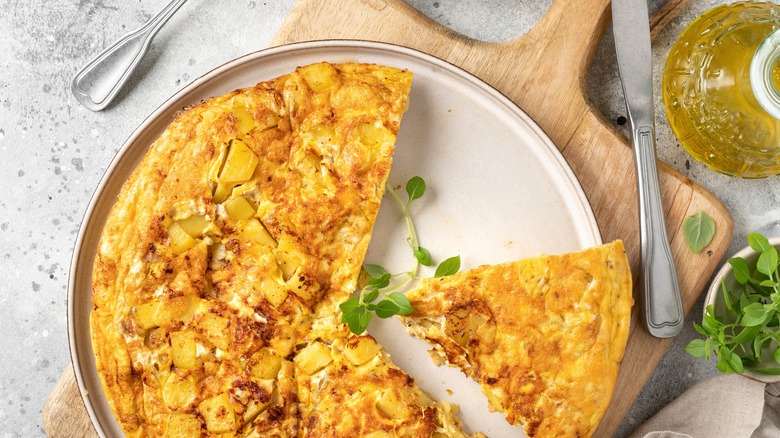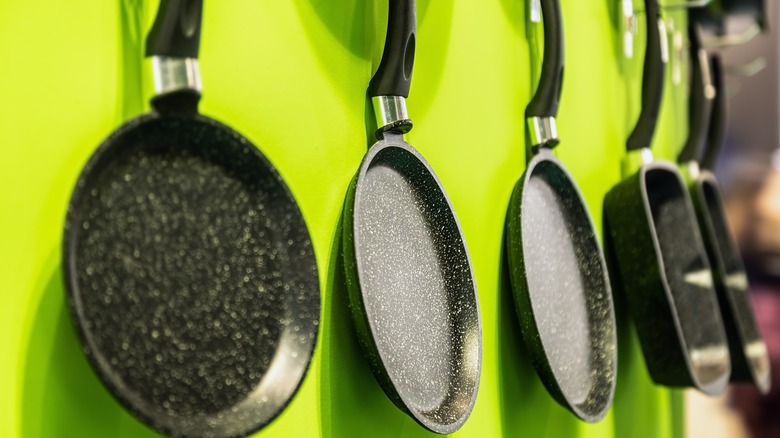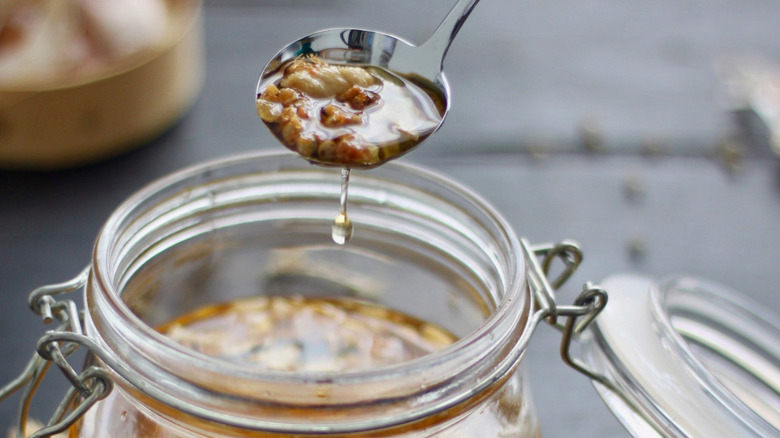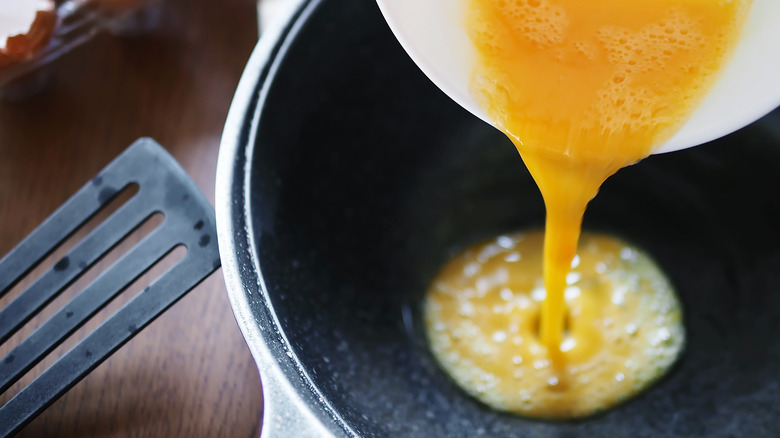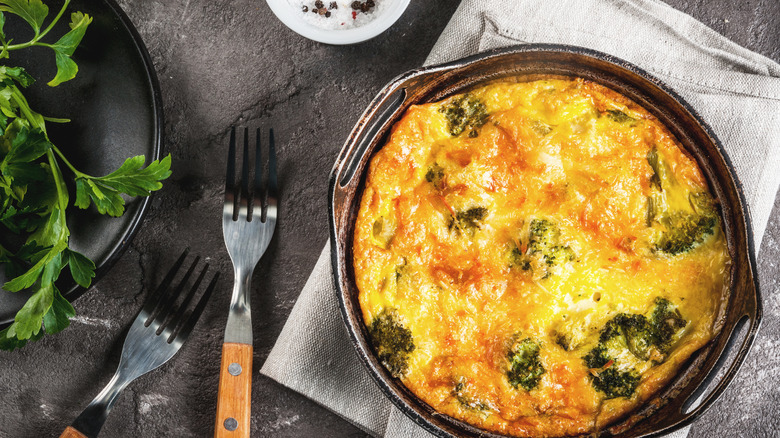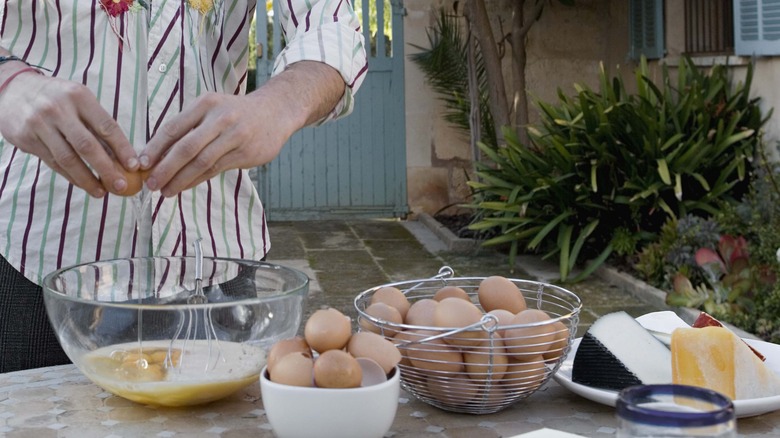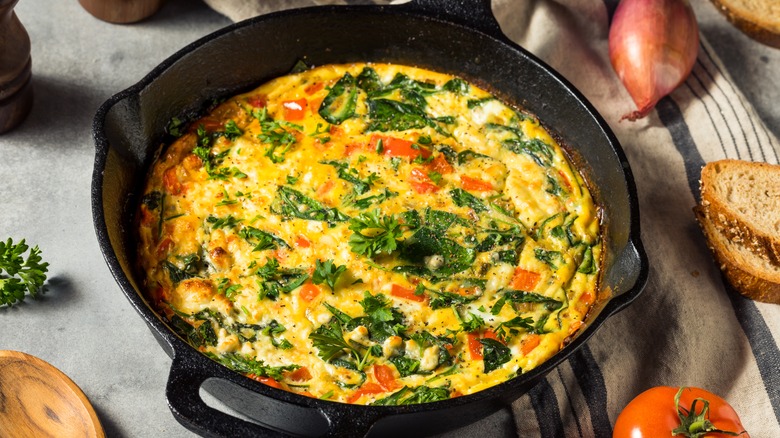13 Cooking Tips For The Absolute Best Frittata
Frittatas are a timeless classic in the world of culinary delights. Famous for their flexibility and simplicity in cooking, these Italian-inspired omelets have become a fixture in households worldwide. Frittatas are an ideal dish to explore new flavors and textures, whether you're an experienced chef or a novice home cook. Don't worry if you haven't cooked a frittata before! This dish is incredibly forgiving and adaptable.
If you're a fan of savory egg dishes, then you've probably come across frittatas on your culinary journey. If not, a frittata is an open-faced dish made with eggs, milk, or cream and fillings like cheese. It may be cooked on the stove and finished under the broiler. It's perfect for a weekend brunch, a quick weeknight dinner, or even an impressive potluck contribution. While easy to make, there are some things you can do to turn an ordinary, easy-to-cook dish into something magnificent.
But what sets a good frittata apart from a truly great one? The secret lies in the details. Crafting a perfect frittata requires attention to detail, from choosing the freshest ingredients to mastering the cooking techniques.
Look for fresh eggs
Eggs are the foundation of a fantastic frittata, and choosing the freshest eggs possible is crucial to achieving the best flavor and texture. The age of an egg can significantly impact its quality and performance in your frittata. As eggs age, their whites become thinner, making the yolks more fragile, leading to a watery frittata with a less-than-desirable texture. On the other hand, fresh eggs have firmer whites and yolks, which help create a fluffy and tender frittata that holds together beautifully.
One easy way to tell if your eggs are good is to check the expiration date or "best by" date printed on the carton. For a more reliable test, try the "float test." Fill a bowl with water and gently place the egg in the water. If the egg sinks and lays flat on the bottom, it's fresh. If it stands upright or floats, it's an older egg best used for other purposes.
Think about buying eggs from a local farmer's market or directly from a farmer when you go shopping. These eggs are usually fresher than those at the supermarket since they haven't been sitting in storage or transit for long. Plus, you'll be supporting local agriculture, which is always a bonus!
Choose quality vegetables
A frittata is a perfect canvas to showcase your favorite veggie's vibrant colors, flavors, and textures. Picking the right ones can elevate your dish from good to absolutely mouth-watering. First and foremost, try to choose vegetables that are in season. You can find a diverse selection of seasonal, locally grown produce that is perfect for your frittata at the nearby farmers' markets. Vegetables from your local farmers' market taste better than your average grocery store, as the produce is often harvested at peak ripeness and sold directly to consumers, which means it is typically fresher than grocery store produce.
After identifying which vegetables are in season, examine their appearance, smell, and texture closely. Look for vibrant colors and a fresh, earthy scent. Avoid any vegetables that appear wilted, discolored, or have an off smell, which are signs of spoilage or poor quality. When it comes to texture, choose produce that feels firm to the touch, with no soft spots or blemishes.
After bringing your carefully selected vegetables home, it's time to prepare them for your frittata. Begin by thoroughly washing the produce under running water to remove dirt or residue. Always remove tough stems, cores, or seeds that could negatively impact the dish's texture. Make sure you avoid some common vegetable-prepping mistakes, such as cutting vegetables unevenly, using a dull knife for cutting, etc.
Pick the right cheese
Different cheeses can bring unique tastes to your frittata, from sharp and tangy to mild and creamy. For example, a strong option like bleu cheese can add a bold flavor that counters beautifully with the mildness of the eggs. In contrast, a calm cheese such as mozzarella can bring a subtle creaminess that elevates the dish without dominating it. You can experiment by combining different cheeses to achieve a well-balanced and harmonious flavor.
Choosing the right cheese for your frittata sometimes gets difficult, but one recommended tip is to consider the melting properties. In a frittata, you want cheese that softens evenly and consistently, ensuring that every bite is filled with gooey goodness. Cheddar, fontina, Gruyère, and Monterey Jack are cheese varieties renowned for superior melting properties, which make them perfect for adding to your frittata.
The cheese's moisture content is also an important aspect to keep in mind. Cheeses with high moisture, such as fresh mozzarella or feta, may release excess liquid while cooking, leading to a potentially mushy frittata. To avoid this issue, opt for cheeses with low moisture or gently pat fresh cheeses dry with a paper towel before adding them to your egg mixture.
Avoid over-whisking your eggs
Properly whisking your eggs is key to achieving a light, fluffy, and tender frittata that will leave you craving seconds (or thirds!). Although there are many specialized tools for whisking eggs, a basic balloon whisk or fork is perfectly suitable for the job. If you prefer using a fork, choose one with long tines for the best results. But remember, don't overmix the eggs. Once you've picked your whisking tool, it's time to start.
Crack your eggs into a large bowl, avoiding any shell fragments. Before whisking the eggs, add your preferred seasonings, such as salt and pepper, to the mixture. This will ensure an even distribution of flavors throughout the frittata.
As you start whisking, use a gentle but thorough motion. The goal is to incorporate air into the egg mixture, creating a frothy consistency resulting in a lighter, fluffier frittata. Whisk until the mixture appears foamy or with some bubbles. One big whisk mistake to avoid is over-beating your eggs. This can incorporate too much air, causing the frittata to rise too much during cooking resulting in a dense, rubbery texture.
Spend some time pre-cooking the ingredients
Since making a frittata is a speedy process, it's crucial to pre-cook the fillings to perfection before adding them to the egg mixture. Many vegetables release moisture as they cook, and if added raw to the egg mixture, they can cause the frittata to turn soggy. By pre-cooking vegetables, you can get rid of extra water and improve texture and flavor.
Begin by chopping your veggies into even-sized pieces. This ensures that they cook evenly and at the same rate. Set a non-stick skillet on medium heat and add a dab of oil or butter. Add your vegetables to the skillet, occasionally stirring to ensure even cooking. If you're using a mix of vegetables with varying cooking times, start with the ones that require longer cooking and add the others later to prevent overcooking.
If you're using proteins like bacon, sausage, or ham, it's crucial to pre-cook them before adding them to the frittata. This step guarantees the proteins are thoroughly done, but it helps remove excess fat that can result in a greasy frittata. Finally, let your pre-cooked ingredients cool slightly before adding them to the egg mixture. This prevents the hot ingredients from partially cooking the eggs before the frittata even reaches the skillet. A few minutes of cooling time should be sufficient.
Season the egg mixture first
Seasoning always adds a ton of flavors to any dish, but there are a few things that you should know before seasoning your frittata. Adding spices and seasoning to your egg mixture first is crucial. It enhances the natural flavors of the ingredients and unites the dish.
Begin by using a pinch of salt to the egg mixture and add to taste. Remember that some ingredients, like cheese and cured meats, will add saltiness to the dish, so be mindful of that when seasoning the eggs. Next, consider adding some freshly ground black pepper. This classic seasoning adds a subtle heat and depth of flavor that complements the other ingredients in your frittata. As with salt, start small. Adding less at a time with give you better adjustments to your taste preferences.
Your frittata can also benefit greatly from the addition of herbs and spices. Parsley, cilantro, and thyme can add lots of brightness and freshness to the dish. Fresh herbs tend to lose flavor when cooked, so rely on these for garnish instead. Dry herbs, however, are better for flavoring your frittata. As with seasonings, add small amounts of herbs and build up as needed to achieve your desired flavor profile.
Choose the right pan
The ideal pan can significantly impact the cooking process, as the right pan will ensure even heat distribution and makes it easier to slide your food onto a plate. Choosing the wrong pan will cause a frittata nightmare, as a pan that isn't oven-safe or doesn't conduct heat well will not cook your frittata properly and may even burn the bottom. When choosing a proper pan for a frittata, a non-stick skillet is your best bet for fried frittatas. Non-stick pans make cooking and flipping your frittata easier without sticking to the pan, ensuring a beautiful and intact final product. Additionally, non-stick pans require less oil or butter, making your frittata healthier without sacrificing flavor.
Another factor to consider when choosing a pan is its oven-safe capabilities. Since frittatas are often finished in the oven to ensure even cooking, selecting a pan with an oven-safe handle and construction is crucial. Look for pans rated for high oven heat, as this will allow for greater versatility in your cooking.
Finally, consider the material of the pan. Cast iron skillets are an excellent choice for frittatas, as they provide even heat distribution and retain heat well, ensuring a perfectly cooked frittata every time.
Pre-heat the pan for a few minutes before cooking
Preheating your pan is an important step that helps ensure even cooking and a beautiful, golden crust on your frittata. When the pan is hot enough, the frittata starts cooking when it hits the surface. This helps the bottom get a nice crust and keeps the egg mixture from sticking to the pan. Preheating the pan also ensures the frittata cooks through without scorching the edges.
Set your pan on the stove over medium heat for a few minutes before adding oil or spices. Cast iron takes longer to heat up to the correct temperature, so be patient if you are preheating a cast iron skillet. You can tell that your pan is good to go when a drop of water sizzles and quickly evaporates as soon as it touches the surface. If the water droplet skids around the pan without evaporating, it's likely not hot enough yet. Conversely, if the water droplet evaporates instantly and the pan is smoking, it's too hot, and you should reduce the heat.
After the pan is heated, add some oil or butter to it so it coats the entire surface. When the oil is hot and shimmering, you're ready to add your pre-cooked ingredients and egg mixture.
Use flavored oils instead of regular cooking oils
You can enhance the taste of your frittatas by flavoring the oil used to cook them. Infusing your oil with your favorite ingredients is also one of the best ways to use up expired spices. There are a lot of specialty shops that sell flavored oils infused with garlic, chili, or truffle, for example. These oils can add an instant burst of flavor to your frittata without requiring any additional effort. While flavored oils can enhance the taste of your frittata, they may be more costly than plain oils. Therefore, it is essential to consider the expense while planning your budget.
If you prefer to save a bit of money, consider making your own infused oil. With just a few minutes of cooking and cooling, you can have an added frittata ingredient that adds a lot of flavors. When using infused oil in your frittata, it's best to add it to the pan before adding your egg mixture. This allows the oil to distribute evenly throughout the frittata and ensures that the flavors are well incorporated.
Pour the egg mixture slowly and evenly
Although pouring the egg mixture seems like a simple step, it can greatly impact the distribution of ingredients and the overall appearance of your frittata. Ensure that the pre-cooked ingredients in the pan are evenly dispersed before adding the egg mixture. This will help make sure that each bite of the frittata contains a balanced mix of flavors and textures.
When pouring the egg mixture, do so slowly and evenly over the pre-cooked ingredients in the pan. This ensures that the ingredients are evenly coated and distributed throughout the frittata. Pouring too quickly may cause the ingredients to shift or clump together, resulting in an uneven distribution. After pouring the egg mixture, you may need to gently stir the ingredients to achieve a more even distribution. This step should be done slowly and minimally, as over-stirring can cause the frittata to become dense and heavy.
Add some grated cheese before transferring to the oven
While some people might finish their frittatas on the stove, following through with an extra step for a perfectly golden brown frittata is recommended. Broiling your frittata is a great option to achieve that perfect crispy texture on the top. But before transferring the frittata to the oven, sprinkle some grated cheese on top for an extra layer of creaminess. If you prefer a stronger flavor, try using sharper cheese like aged cheddar or even blue cheese.
After adding the cheese, it's time to broil your frittata. Carefully transfer your frittata to the preheated oven and broil for a few minutes until the cheese is melted, bubbly, and lightly browned. Be sure to keep a close eye on your frittata during this stage, as broiling can quickly go from perfect to burnt in a matter of seconds. If you notice the cheese or edges of the frittata starting to darken too quickly, simply move the pan to a lower rack or crack the oven door slightly to reduce the heat.
Be mindful of the egg-to-dairy ratio
One of the secrets to crafting a truly delectable frittata is achieving the perfect balance of eggs and dairy. You should always add dairy to frittatas as it can help prevent the eggs from becoming too tough or rubbery when cooked.
Your frittata's outcome, including the level of creaminess and overall structure, heavily relies on the egg-to-dairy ratio. Too little dairy can produce a dry and rubbery texture, while too much dairy can make the frittata overly soft and custard-like. Finding your frittata's golden ratio between eggs and dairy will help ensure the final dish is delicate, juicy, and creamy.
Your selection of dairy for the frittata can influence the dish's flavor and texture. Milk is a great option for a lighter, more delicate frittata. Whole milk is preferred since its higher fat content yields a creamier texture than skimmed or reduced-fat milk. For a richer and denser frittata, heavy cream or whipping cream is a great option, while half-and-half serves as an ideal milk-cream combination. When making your frittata, add the dairy after the eggs are beaten but before you add the fillings. This ensures that the dairy is evenly distributed throughout the mixture.
Make sure that the frittata cooks evenly
A frittata cooked to perfection is a feast for the eyes – delicate, moist, and bursting with flavor. However, achieving this level of culinary finesse can be difficult, especially when it comes to guaranteeing that your frittata cooks evenly.
The key to a frittata that is both tender and moist lies in even cooking. When a frittata is cooked unevenly, it can result in parts that are overcooked and elastic, while other sections remain undercooked and runny. Ensuring that your frittata cooks evenly throughout will provide a consistent texture and prevent any unpleasant surprises when it's time to dig in.
During the frittata's cooking process, monitor the heat closely and make necessary adjustments to maintain a consistent, low cooking temperature. This will help to prevent the bottom of the frittata from burning or becoming too brown while the top remains undercooked. There is also a really easy way to tell when your frittata is done — a well-cooked frittata will jiggle slightly after you take it out of the oven.
Static Media owns and operates Tasting Table and Mashed.
